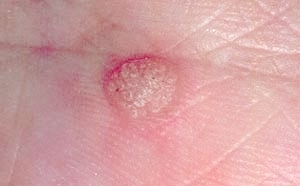Learn all about verruca vulgaris sign and symptoms and treatment. “Common” warts (verruca vulgaris) are single or grouped, rough keratotic papules, nodules, or plaques. Verrucas are usually found on the soles of your feet. They may also have tiny black dots in the centre and can be painful when you put weight on them. They tend to look quite flat because of the pressure put upon them.
Verruca vulgaris has a rough surface and usually appears on the hands or feet. They can occur on the back of fingers or toes and on the knees. The warts are small blisters that appear usually on the hands or under the feet (so called verrucas). They are also seen them in groups or a linear pattern. They are often slightly raised, have hard edges and softer centers. They may be either lighter or darker than the surrounding skin. There may be small black dots in the warts as well. Warts on the hands are usually more visible and larger in size. They may look like tiny cauliflowers. Warts may appear in various shapes and sizes. For example, the size of a wart can range from 1mm to over 1cm in diameter.
A Verruca resembles a lumpy bump on the skin, often surrounded with callus. Lateral pressure will give pain, whereas pressing the Verruca from underneath will rarely give a painful response. Any attempt at removing tissue from it, results in bleeding this is because they are highly vascular and this is the best way of recognising whether you are looking at a ‘Corn’ or a Verruca the vascularity.
Warts and verrucas are common all over the world. No one’s sure exactly how many people get them, but they are most common in school-aged children and young adults. The physician takes into account several factors like history of sharing community showers etc., familial or partner history of such warts as these are contagious and history of eczema and conditions where there is a risk of reduce immunity like AIDS, transplant, leukemias or lymphomas.
Warts are usually harmless in people whose immune systems are working properly, and it is rare for any malignant (cancerous) change to develop in a wart. However, people with a weakened immune system have a higher risk of a wart becoming malignant. If you seek medical care, liquid nitrogen cryotherapy is the most common treatment for common warts. Other treatment methods include topical agents, intralesional injections, systemic agents, cryotherapy, laser, electrodessication and surgical excision.
Verruca Vulgaris Symptoms
Symptoms of verruca vulgaris are as under;
- Verrucas are often painful due to their location. They commonly occur on pressure areas of the feet like the heels or the balls of the feet, they may hurt. Most patients tend to avoid putting weight over the warts and end up with an altered posture and gait. This leads to pain in the legs and the back as well.
- These can be itchy.
- On scratching the warts may bleed as well.
- Verruca may be single or more than one clustered together. These are called mosaic warts.
- The verrucae are round or oval in shape and are firm and raised or flattened. Their surface is irregular and typically like a cauliflower.
- The skin around the verruca is white in color. There is often a black dot in the centre that is actually the blood vessel lying underneath.
- Verruca may not be typically raised but may be flattened due to their occurrence over the pressure areas of the feet and constant pressure over them. The weight of the body may force the warts to grow back into the skin.
- Verruca may spread due to scratching, biting, finger sucking or shaving to other parts of the body like fingers, nails, mouth, face etc. This occurs due to breakage of the warts and release and spread of the virus to other areas.
Verruca Vulgaris Causes
The major cause of verruca vulgaris is HPV which is spread by direct skin-to-skin contact or autoinoculation. This means if a wart is scratched or picked, the viral particles may be spread to another area of skin. The incubation period can be as long as twelve months. It can also be passed on by indirect contact, for example, from contaminated objects, such as towels and shoes. Warts are thought to be contagious for as long as they are present on your body.
Verruca Vulgaris Treatment
Verruca vulgaris treatment includes
Topical treatment
Cryotherapy commonly used
- Duct tape or moleskin
- Topical salicylic acid
- Photodynamic therapy with 5-aminolevulinic acid
- Many other treatments that are used but supported only by limited or no clinical data
Electrosurgery
Other experimental treatments for recurrent, resistant or extensive warts include: - Topical retinoids, such as tretinoin cream or adapalene gel
- The immune modulator, imiquimod cream
- Bleomycin injections
- Oral retinoids
- Pulsed dye laser destruction of feeding blood vessels
- Photodynamic therapy
- Laser vaporisation
- H2 receptor antagonists
- Applications of raw garlic or tea tree oil
- Immune stimulation using diphencyprone (diphenylcyclopropenone), squaric acid
- Immunotherapy with Candida albicans or tuberculin PPD
- Hyperthermia
- Cantharidin
- Bichloroacetic acid
- Dinitrochlorobenzene solution
- Silver nitrate solution
- A-Lactalbumin plus oleic acid
- Formic acid
- Ciclopirox-containing lacquer
- Intralesional injection of skin test antigens
- Combination of 5-fluorouracil, lidocaine, and epinephrine
- Oral zinc sulfate, cimetidine, levamisole
- Hypnotic and “suggestion” therapies, including use of “wart tape”
Verruca Vulgaris Pictures
 Health & Care Information
Health & Care Information 



